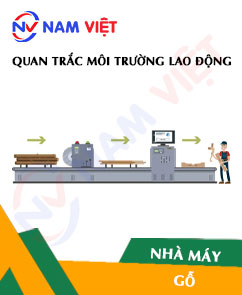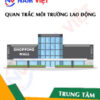Occupational environment monitoring of a wood manufacturing factory
99,000 ₫
Note: The above price is calculated for one sample, and the price may fluctuate depending on the area of the environment to be monitored and market movements. For more accurate pricing support, please refer to the price list or contact our consulting staff directly.
Monitoring the environment of a wood manufacturing factory is a session of collecting, analyzing, and evaluating factors at the workplace that may harm workers health.
Table of Contents
Toggle1. Overview of Wood Factory
a. What is a Wood Factory?
A wood factory is a specialized production facility for processing and manufacturing wood products. Wood factories are usually equipped with modern machinery and equipment to carry out the stages of treatment, cutting, processing, and finishing wood into various products.
Common products processed in wood factories include furniture, plywood, flooring, doors, stairs, construction wood, decorative items, and many other wood products. Wood factories play an important role in the wood industry and meet market demand for wood products.

b. Production Stages in a Wood Factory
The production stages in a wood factory may include:
- Receiving and processing wood: Wood is transported and received at the factory, then processed to remove unwanted parts such as bark, branches, and stones. This process may include cutting, trimming, peeling, and splitting wood into smaller volumes.
- Shaping and processing wood: After being received and processed, wood is shaped and processed to create the desired products. This stage includes cutting, sanding, drilling, turning, milling, and carving to create details and shapes as required.
- Smoothing and finishing: Once wood has been processed and shaped, smoothing and finishing steps are performed to improve surface quality and product appearance. This may include machine or manual sanding, painting, applying scratch-resistant coatings, and polishing to achieve the final desired result.
- Assembly and final finishing: Processed wood parts are assembled into the final product, using joining, connecting, and fastening techniques to complete the product. Quality checks are also performed to ensure products meet safety and quality standards.
- Packing and transportation: After completion, products are packed and prepared for delivery to retail points or end customers. Safe and effective packing ensures products are not damaged during transportation.
Production processes may vary depending on product types and the scale of the factory.

c. Types of Machinery Used in a Wood Factory
In wood factories, various machinery and equipment are used for processing and manufacturing wood. Some common machines include:
- Saws: Including table saws, automatic saws, circular saws, and band saws, used to cut wood into smaller pieces or thin plywood layers.
- Wood lathes: Used to create cylindrical, spherical, or other shaped details by rotating wood and using cutting tools.
- Sanders: Including belt sanders, bench sanders, and edge sanders, used to smooth surfaces and edges of wood products.
- Gluing machines: Used to join wood pieces together to create larger parts or complete products.
- Polishing machines: Used to brighten wood surfaces and polish for a smooth, glossy finish.
- Engraving machines: Utilize laser or CNC cutting technology to create patterns and inscriptions on wood surfaces.
- Wood presses: Used to press layers of wood together to make plywood or thicker panels.
- Drilling machines: Used to drill holes in wood for installing accessories, bolts, or other components.
- Edge milling machines: Used to mill edges of wood panels for precise and sharp edges.
- Cleaning and dust collection machines: Used to remove dust and waste from processing, ensuring a clean and safe working environment.

d. Occupational Diseases for Workers in a Wood Factory
Workers in wood factories may suffer from certain occupational diseases due to exposure to harmful factors during wood processing. Common occupational diseases in the wood industry include:
- Respiratory diseases: Exposure to wood dust and fumes during cutting, sanding, and processing may cause respiratory problems such as pneumonia, sinusitis, and asthma.
- Skin diseases: Chemicals in wood and solvents used in painting or coating surfaces may cause skin irritation, allergies, dermatitis, and eczema.
- Ear problems: Noise from machinery and cutting tools may cause hearing damage, including hearing loss and tinnitus.
- Hand and joint problems: Repetitive work and prolonged use of hand tools may cause issues such as bursitis, joint degeneration, and cervical spine degeneration.
- Eye problems: Exposure to wood dust and fine particles during processing may cause eye irritation and injuries, including conjunctivitis.
- Mental health issues: Working in a noisy, dusty, and high-pressure environment may lead to stress, depression, and anxiety.

e. Types of Products in a Wood Factory
Wood factories produce a wide range of wood products. Common products include:
- Plywood and panels: Created by gluing and pressing wood layers together. Used in furniture, construction, and exterior applications.
- Sawn wood: Produced by cutting wood into thin boards along the grain. Used for flooring, partitions, doors, furniture, and veneers.
- Wood flooring: Common interior product made by assembling and processing wood into floor panels. Available in various designs, materials, and colors.
- Furniture: Includes tables, chairs, beds, cabinets, shelves, and other wooden furniture.
- Doors and windows: Wooden doors for main entrances, rooms, and interiors; wooden windows for buildings and homes.
- Veneered and laminated wood: Used in construction and furniture production. Veneered wood combines small wood pieces into larger panels, while laminated wood combines pieces into complete products.
- Engineered wood: Widely used in furniture and construction, made from hardwood or softwood treated and processed to meet specific requirements.

2. Overview of Workplace Environmental Monitoring Services
a. What is Workplace Environmental Monitoring in a Wood Factory?
Workplace environmental monitoring (or occupational environment measurement) in a wood factory is the activity of collecting, evaluating, and analyzing indicators of occupational environmental factors to take timely measures, reduce environmental harm to workers’ health, and prevent occupational diseases. Workplace environmental monitoring is mandatory for wood factories.
Monitoring plays a crucial role in protecting and improving workers’ health, as employees are the main resource and directly generate profit for businesses. Workers who are frequently exposed to hazardous factors above permissible limits may experience health issues and occupational diseases.
REGISTER FOR WORKPLACE ENVIRONMENTAL MONITORING SERVICE
b. Nam Viet’s Workplace Environmental Monitoring Program
Nam Viet’s workplace environmental monitoring program is developed by monitoring engineers in occupational safety and environmental protection. To ensure the health and safety of workers, it uses modern measurement methods to monitor air quality, water, microclimate, physical factors, dust, and more in the workplace. This program is essential for ensuring a safe working environment and protecting workers’ health.
Additionally, Nam Viet’s program contributes to research and developing new solutions to improve workplace environmental quality. With a dedicated and professional team of monitoring experts, Nam Viet’s exclusive program represents a breakthrough in occupational safety and environmental management in Vietnam.

c. Standardization in Workplace Environmental Measurement Procedures
Standardization in Nam Viet’s workplace environmental measurement procedures ensures the quality and reliability of results. The program follows recognized standards from the Ho Chi Minh City Department of Health. This ensures collected data is reliable for evaluating workplace environments and making decisions to improve worker safety.
Standardized procedures also ensure that measurements are conducted by highly qualified monitoring specialists with years of experience, allowing managers and experts to trust Nam Viet’s results for accurate decision-making.
By applying standardized procedures, Nam Viet demonstrates its commitment to providing a safe working environment, protecting employees’ health, and contributing to the development and improvement of occupational safety and environmental management in Vietnam.
d. Reporting Results of Wood Factory Environmental Monitoring
Monitoring results are prepared according to Form 04, Appendix III issued with Decree 44/2016/ND-CP and made in two copies: one for the contracting wood factory and one for the monitoring organization.
The legal retention period for monitoring results is indefinite.

e. Frequency of Workplace Environmental Monitoring According to the Law
According to Clause 2 of Article 18 of the Law on Occupational Safety and Hygiene 84/2015/QH13, employers must conduct workplace environmental monitoring at least once a year.
f. Deadline for Submitting Workplace Environmental Monitoring Reports According to the Law
The deadline is before December 31 each year. Production enterprises must submit monitoring reports to the Department of Health in the locality of their headquarters and workplaces.
When there are changes in technology or production processes, or when upgrading facilities that may introduce new hazards, enterprises must update occupational hygiene records regarding harmful factors requiring workplace environmental monitoring.
g. Penalties for Violations of Workplace Environmental Monitoring Regulations for Employers
According to Article 27 of Decree 12/2022/ND-CP dated January 17, 2022:
- Clause 2: Fine of 2,000,000 – 5,000,000 VND for failing to publicly disclose monitoring results to workers at the monitored workplace.
- Clause 3: Fine of 20,000,000 – 40,000,000 VND for failing to conduct workplace environmental monitoring to control health hazards.
- Clause 4: Fine of 40,000,000 – 60,000,000 VND for colluding with monitoring organizations to falsify monitoring activities without criminal liability.
3. Harmful Environmental Factors for Workers in Wood Factories
Workers in wood factories may be exposed to the following harmful environmental factors:
- Wood dust: The wood processing process can generate wood dust, including fine particles from cutting, sanding, and machining. Wood dust can cause respiratory irritation, pneumonia, and other respiratory problems.
- Wood fumes: During wood processing, organic compounds in the wood may evaporate and form wood fumes in the air. Wood fumes can irritate the eyes, nose, throat, and respiratory tract, causing breathing difficulties, nausea, and nervous system damage.
- Chemicals: Chemicals used in painting, surface coating, and wood treatment may irritate the skin, eyes, and respiratory system. Some chemicals, such as formaldehyde and solvents, can cause skin allergies, dermatitis, and respiratory issues.
- Noise: Machinery and tools in wood factories generate high noise levels, especially during cutting, sanding, and machining. Noise can cause ear damage and hearing loss.
- Temperature and humidity: Working environments in wood factories may experience fluctuations in temperature and humidity. These changes can affect worker comfort and health, causing discomfort and increasing the risk of respiratory infections.
- Emissions: The burning of wood or the use of machinery in wood factories may produce emissions and air pollutants. Pollutants such as volatile organic compounds, halogenated organic compounds, carbon monoxide, and fine particles can impact workers’ health.
REGISTER FOR WORKPLACE ENVIRONMENT MONITORING SERVICE
4. Measures to Improve Working Environment in Wood Factories
To improve the working environment in wood factories and protect worker health, the following measures can be applied:
- Ventilation system: Ensure an effective ventilation system to remove dust and wood fumes from the working air. Use dust extraction systems and ventilation fans to maintain clean and safe air.
- Training and guidance: Provide training and guidance for workers on proper use of personal protective equipment, safe work procedures, and occupational disease prevention measures.
- Personal protective equipment: Ensure workers are fully equipped and properly use personal protective equipment such as masks, safety goggles, gloves, ear protection, and protective clothing to guard against harmful environmental factors.
- Equipment inspection and maintenance: Regularly inspect and maintain machinery and equipment in wood factories to ensure they operate efficiently and safely.
- Waste management: Process and dispose of waste from wood processing according to proper procedures and safety guidelines. Ensure recycling and waste handling comply with environmental regulations.
- Risk assessment: Conduct environmental and health risk assessments to identify potential hazards and apply appropriate preventive measures.
- Workplace monitoring: Regularly monitor air quality, noise levels, and other environmental factors to ensure compliance and make adjustments as needed.
- Periodically conduct workplace environment monitoring in factories, collecting and analyzing harmful factors for workers, and adjusting to reduce risks to prevent occupational diseases.
5. Benefits of Periodic Wood Factory Monitoring
An Toan Nam Viet provides enterprises with great benefits when using workplace environment monitoring services in accordance with Decree 44/2016/ND-CP on managing and controlling harmful factors in the working environment affecting workers.
- Enterprises can proactively control harmful factors in workshops or factories.
- Receive consultancy and recommendations to reduce harmful factors and improve workplace quality.
- Indirectly protect human resources, the main factor in enterprise development.
- Minimize occupational disease impacts on worker health, thereby reducing future medical costs.
- Improved worker health leads to better product quality and maintained output.
- Comply with labor safety regulations, avoiding legal risks.
- Create reputation and professionalism in all aspects, elevating the enterprise’s brand.
Nam Viet’s environmental monitoring service is a solution to reduce occupational disease harm and contribute to a clean and high-quality working environment.

6. Nationwide Workplace Environment Monitoring Center
Workplace Environment Monitoring Center of Nam Viet is a professional unit in supervising and measuring workplace environment quality across all provinces in Vietnam. With an experienced team of monitoring specialists, the center uses modern measurement devices to ensure accuracy and reliability.
Besides providing monitoring services, the center supports clients in planning, handling, and tracking workplace environment issues. Following the motto “customer-centric”, the center focuses on customer satisfaction, meeting all client needs, and providing the best solutions for enterprises.
REGISTER FOR WORKPLACE ENVIRONMENT MONITORING SERVICE
With investment in technology, equipment, and human resources, Nam Viet’s monitoring center has become one of the most reputable units in workplace environment monitoring in Ho Chi Minh City with the following goals:
- We always value our brand reputation and the quality of our services.
- We provide customers with the best and most suitable solutions.
- Along with experienced Masters and Engineers, committed to environmental protection and enterprise benefits.
- By partnering with Nam Viet Environmental Monitoring, your company receives professional service from experts in monitoring, with the best cost benefits.
The process of workplace environment monitoring at Nam Viet includes the following basic steps:
- Before conducting monitoring, we ensure all equipment is calibrated and adjusted according to legal regulations.
- Strictly follow the monitoring process agreed with the Department of Health.
- Accurately report monitoring results to the employer.
- If the monitoring results do not ensure worker safety, Nam Viet will provide solutions, and the workplace will implement the following:
- Implement measures to improve working conditions to minimize the effects of harmful factors and prevent occupational diseases.
- Organize medical examinations to detect occupational diseases and related illnesses for workers in unsafe work environments.
- Provide in-kind compensation to workers according to labor law regulations.

7. Workplace Environment Monitoring Price List
To help enterprises conduct workplace environment monitoring professionally and effectively, Nam Viet provides customers with a quality and reasonably priced monitoring service price list.
- Our price list provides detailed information on the costs of our monitoring services, including travel, measurement, analysis, and reporting. Customers can fully rely on the accuracy and reliability of the monitoring reports we provide.
- We commit to offering the most competitive and reasonable prices on the market and are always ready to quickly and professionally answer any monitoring service inquiries.
- With Nam Viet’s monitoring price list, customers can easily select service packages that suit their needs. We guarantee maximum satisfaction with professional service quality.
1 review for Occupational environment monitoring of a wood manufacturing factory
No comments yet












maituyet.cuong12
Professional labor environment monitoring unit